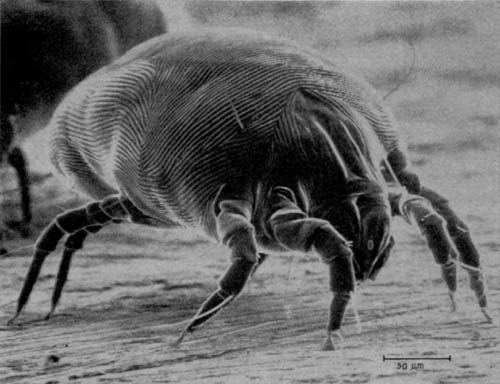House Dust Mite (Dermatophagoides pteronyssinus) - Wiki House dust mite
From Wikipedia, the free encyclopedia
Order: Acariformes
Family: Pyroglyphidae
[Photo] House Dust Mite (Dermatophagoides pteronyssinus) from Food and Drug Administration website (www.fda.gov). Public Domain.
The house dust mite (sometimes abbreviated by allergists to HDM), is a cosmopolitan guest in human habitation. Dust mites feed on organic detritus such as flakes of shed human skin and flourish in the stable environment of dwellings. In nature they are killed by micro-predators and by exposure to direct sun rays. Dust mites are considered to be the most common cause of asthma and allergic symptoms worldwide.[weasel words] The enzymes they produce can be smelled most strongly in full vacuum cleaner bags. The European house dust mite (Dermatophagoides pteronyssinus) and the American house dust mite (Dermatophagoides farinae) are two different species.
Size
It is possible to see a dust mite under a magnifying glass, when the subject is well lit and placed on a black background. A typical house dust mite measures 420 ??m in length and 250 to 320 ??m in width. Both male and female adult house dust mites are globular in shape, creamy white and have a striated cuticle. A member of the phylum Arthropoda, larval and post-larval stages of house dust mites have eight legs. Dust mites can be transported airborne by the minor air currents generated by normal household activities.
Life cycle
The average life cycle for a male dust mite is 20 to 30 days, while a mated female dust mite can live for 10 weeks, laying 60 to 100 eggs in the last 5 weeks of her life. In a 10 week life span, a dust mite will produce approximately 2000 fecal particles and an even larger number of partially digested enzyme-infested dust particles.
A simple washing will remove most in the waste water. Temperatures of over 60 degrees Celsius (140 degrees Fahrenheit) for a period of one hour, and freezing are usually fatal to dust mites; a relative humidity less than 50 may also be fatal. Dust mites reproduce quickly enough that their effect on human health can be significant.
Habitat and food
The dust mite survives in all climates, except at high altitudes where reproduction is halted. A necessary condition for growth (digestion and reproduction) is sufficient absolute humidity. Relative humidity is not a good measure since it varies with temperature. When humidity is less than optimal, dust mites function more slowly, eventually become dormant and may die. Dust mites thrive in the environment provided by beds, kitchens and homes in general, where the sun's rays do not reach them. Mites remain in mattresses, carpets, furniture and bedding, since they can climb lower down through the fabric to avoid sun, vacuum cleaners, and other hazards, and climb higher up to the surface if necessary to get another skin cell to feed on, when humidity is high. Even in dry climates, dust mites survive and reproduce easily in bedding (especially in pillows) because of the humidity generated by the human body during several hours of breathing and perspiring.
Dust mites consume minute particles of organic matter. Some species of mites prefer to eat skin cells, a large component of household dust; others prefer flour dust. Dust mites have a rudimentary alimentary system (no stomach) and require most digestion to occur outside their body. For this reason they secrete enzymes and deposit the fungus Aspergillus repens on dust particles, to enable the fungus to pre-digest the organic matter with its enzymes. Dust mites eat the same particle several times, only partially digesting it each time. Between feedings dust mites leave particles to decompose further. Ultimately a fully digested particle, which a dust mite will not eat, is deemed by scientists to constitute fecal matter.[weasel words] On average, a person sheds about 1.5 grams of skin cells and flakes every day (approximately 0.3-0.45 kg per year), which is enough to feed roughly a million dust mites under ideal conditions. Dust mites in bedding derive moisture from human breathing, perspiration, and saliva.
Asthma and allergies
The house dust mite's partially digested food, and fecal matter, is one of the most significant sources of allergens, implicated in allergic asthma, rhinitis, conjunctivitis and dermatitis. One of the more important proteins responsible for the allergic reaction is DerP1, a protease digestive enzyme found in mite feces. Dust mite bodies, comprised of chitin, are also allergens. Immunotherapy or "allergy shots" have been helpful for sufferers of hay fever and asthma. Steam cleaners may be effective at reducing enzyme allergens since the heat of the steam breaks down (decomposes) the compound. Prolonged exposure of skin to the proteins in dust mite fecal matter reduces its barrier function; this weakness can create a point of entry for allergens and irritants, leading to inflammation and itchiness or pruritis.
http://en.wikipedia.org/wiki/House_dust_mite
| The text in this page is based on the copyrighted Wikipedia article shown in above URL. It is used under the GNU Free Documentation License. You may redistribute it, verbatim or modified, providing that you comply with the terms of the GFDL. |
